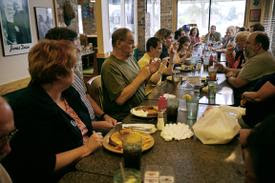Illinois sign language suppers build relationships between deaf, hearing communities

From
The State Journal-Register in Springfield, Ill.:
When Cathi Blickenstaff and Erin Rachford met for the first time at a youth retreat, they had a hard time communicating. That’s because Blickenstaff is deaf and Rachford didn’t know sign language.
“Cathi sparked my interest in signing,” said Rachford, a nurse at St. John’s Hospital who sometimes deals with patients who cannot hear.
She took American Sign Language classes and then started accompanying Blickenstaff to informal Monday night restaurant dinners known as “Silent Suppers” or “Deaf Dinners.”
The 5 p.m. get-togethers, held weekly at various Springfield eateries, provide opportunities to improve sign language skills and to socialize.
“Hearing people are welcome to join, and it’s good for those who are learning to know how to use sign language to communicate with the deaf at a comfortable level,” said Pat Gurley, a state employee who hosts the dinners with Blickenstaff.
“Sometimes we have people coming in from Jacksonville and Decatur. Even some college students who are home on breaks join us,” she said.
Attendance ranges from 10 to 30 per week. The suppers, which last about two hours, alternate between restaurants on the east and west sides of towns. Good lighting and long tables allow diners to see each other, encouraging interaction.
Silent Suppers started in November 2000, when a deaf person was going through a personal crisis and wanted to meet regularly with other deaf people.
“After a conversation at a movie theater where we watched an open-captioned movie, a few friends thought it was a good idea and decided to start the concept of having a Deaf Dinner,” Gurley said. “This concept is gaining popularity in other deaf communities throughout the state
and country as well.”
Don Witty, a retired state employee, used to teach sign language classes at the Springfield Center for Independent Living.
“You know, there are hearing groups that go out after work. This is the same. I like that it’s really helped the communication to improve.”
Witty says there are various reasons hearing people are motivated to learn sign language — they might have family members or friends with a hearing loss, or they might have a job, such as in a hospital, where sign language is useful.
He estimated it takes 5 to 8 years for a hearing person to become highly skilled in American Sign Language. Children, he said, are difficult to teach because “they’re always looking around.”
According to the Bethesda, Md.-based National Institute on Deafness and Other Communication Disorders, age is critical when it comes to learning to sign, whether it is a first or second language. Exposure should come as early as possible, preferably before school age, to become fully competent.
The institute says native signers consistently display more accomplished sign-language ability than those who learn it later in life.
“It makes me happy to have hearing people use sign language,” Witty said.
Topics at recent Silent Suppers ranged from the dearth of real-time captioning on local TV weather reports to legislation that would require insurance companies to pay for hearing aids.
The get-togethers also provide a forum to vent frustration.
“Deaf people can do anything. We’re not handicapped. I can do anything,” said Leon Debriendt of Moline, who attended a supper while in Springfield on business. “People have a lot of stereotypes. They think deaf people are all the same.”
“We live in a hearing world and we want the same things, but we’re always behind. We’re always trying to catch up,” said Marion Dramin, outreach manager for the Illinois Telecommunications Access Corp. The organization provides TTYs (teletypewriters) and videophones for the deaf.
Dramin has four generations of deafness in her family, from her parents to two of her grandchildren.
She grew up reading lips and learned sign language when she got married. She said it’s easier for her deaf grandchildren to communicate than it was for her or her parents.
“We have more equality now. The world has opened up to us. My mother is 99, and she uses the videophone every day. She loves it. We have TTYs and pagers,” Dramin said.
“Computers allow deaf people to be equal with access to communication. We can communicate and no one would ever know we’re deaf,” she added.
Lori Thompson can hear, but she was prompted to learn sign language so she could communicate with a friend who lives in Jacksonville. Thompson, a library cataloger at Southern Illinois University School of Medicine, has been attending the Springfield Silent Suppers for three years.
“I came to improve my communication skills. Now I come to see my friends,” she said.
There’s also a “Deaf Coffee,” a group that meets at 6 p.m. the first Thursday of each month. The location is Panera Bread, and it alternates between the Dirksen Parkway and West White Oaks Drive locations. Drop-ins are welcome.
Like Silent Suppers, Deaf Coffees provide a chance to see friends and practice signing.
“I have three cousins who are hard-of-hearing,” said Rachel Cowle-Healy, a pastor and former teacher of the deaf who runs the group.
Blickenstaff and Rachford get together to chat each Monday at the Silent Suppers. Sitting across from each other, they sign and frequently laugh.
“She’s gotten much better at this,” Blickenstaff said. “It’s so much easier now.”
 From The State Journal-Register in Springfield, Ill.:
From The State Journal-Register in Springfield, Ill.: